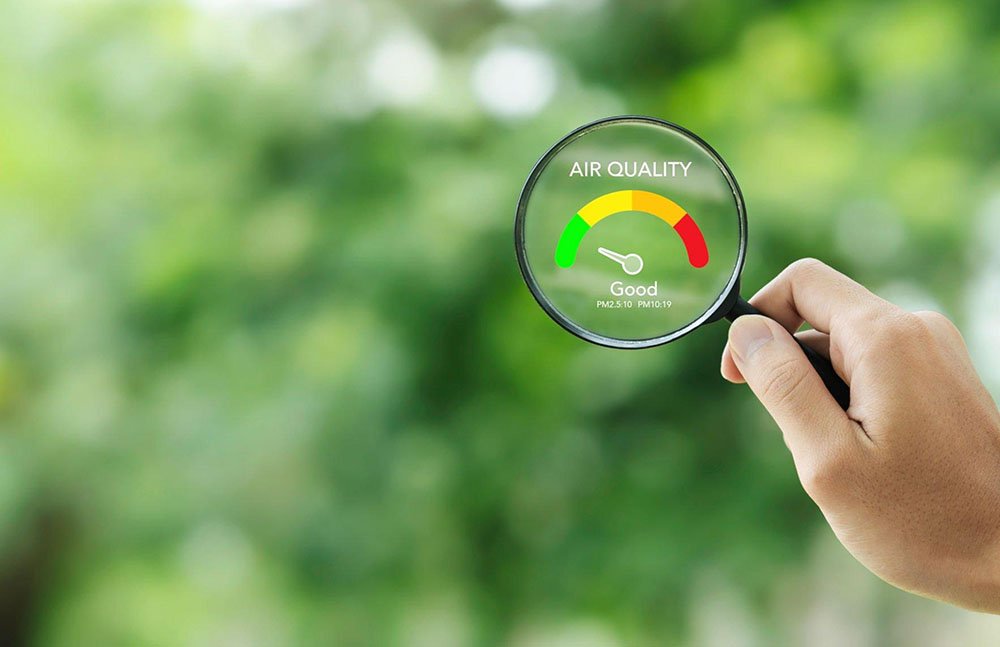Home / Blog / Air Quality Monitoring: Ensuring Clean Air in the Middle East
Air Quality Monitoring: Ensuring Clean Air in the Middle East
Introduction
What is air quality monitoring?

Air quality monitoring is the process of measuring and tracking the levels of air pollutants in the atmosphere. Air pollutants are harmful substances that can cause health problems and damage the environment. Some common air pollutants include particulate matter (PM), ozone (O3), nitrogen dioxide (NO2), sulphur dioxide (SO2), and carbon monoxide (CO).
Which can be done using various methods, including ground-based, satellite, and mobile monitoring stations. Ground-based monitoring stations are the most common type of air quality monitor. They are typically located in fixed areas, such as urban and industrial areas, and near major roads. Satellite monitoring can measure air quality over large areas, but ground-based tracking is more accurate. Mobile monitoring units measure air quality in specific locations, such as construction sites and busy intersections.
Why is air quality monitoring necessary in the Middle East?
This is essential in the Middle East because the region faces several air quality challenges. These challenges include:
- Dust storms: Dust storms are common in the Middle East, especially during the summer months. Dust storms can carry large amounts of particulate matter, which can cause respiratory problems and other health problems.
- Heat waves are becoming more frequent and intense in the Middle East due to climate change. Heat waves can increase air pollution levels and make it more difficult for people to breathe.
- Pollution from vehicles and industry: Vehicles and industry are significant sources of air pollution in the Middle East. Air pollution from vehicles and industry can cause various health problems, including respiratory problems, heart disease, and cancer.
The benefits of air quality monitoring
Air quality monitoring has several benefits, including:
- Protecting public health: It can help to protect public health by identifying sources of air pollution and tracking changes in air quality over time. This information can be used to develop and implement air quality management strategies to reduce air pollution levels and protect human health.
- Reducing economic costs: Air pollution can have a significant economic impact due to the cost of treating health problems caused by air pollution and the loss of productivity due to sick days. Air quality monitoring can help to reduce these costs by helping to identify and reduce sources of air pollution.
- Improving environmental quality: Air pollution can damage the environment, including plants, animals, and ecosystems. Which can help to improve environmental quality by helping to identify and reduce sources of air pollution.
The challenges of air quality monitoring in the Middle East
The Middle East faces many challenges in air quality monitoring, including:
- Hot and dry climate: The Middle East has a hot and dry environment, making it difficult to maintain and operate air quality monitoring equipment.
- Large and growing population: The Middle East has a large population, which strains resources and can increase air pollution levels.
- Rapid urbanization: The Middle East is experiencing rapid urbanization, which can lead to increased air pollution levels from vehicles and industry.
In addition to these challenges, the Middle East also faces several specific air quality challenges, such as dust storms and heat waves. Dust storms can carry large amounts of particulate matter, which can cause respiratory problems and other health problems. Heat waves can increase air pollution levels and make it more difficult for people to breathe.
Here are some specific examples of how the Middle East’s climate, population, and urbanization patterns can challenge air quality monitoring:
- Hot and dry climate: Extreme heat can damage air quality monitoring equipment, making it challenging to collect accurate data. Dust storms can also damage equipment and make it difficult to operate.
- Large and growing population: The Middle East’s large population means a high demand for air quality monitoring data. However, the region’s resources are limited, making it challenging to deploy and maintain sufficient air quality monitoring stations.
- Rapid urbanization: Rapid urbanization is leading to the construction of new cities and roads and the expansion of existing cities. This can lead to increased air pollution levels from vehicles and industry.
Despite these challenges, the Middle East has made significant progress in air quality monitoring in recent years. Several countries have air quality networks and use data to manage air quality.
Here are some examples of how the Middle East is addressing the challenges of air quality monitoring:
- Hot and dry climate: Some Middle Eastern countries use solar-powered air quality monitoring stations to reduce their reliance on the grid. Other countries are developing new air quality monitoring technologies more resistant to heat and dust.
- Large and growing population: Some Middle Eastern countries use satellite and mobile monitoring units to supplement their ground-based air quality monitoring networks. This allows them to collect data from a broader range of areas.
- Rapid urbanization: Some Middle Eastern countries use air quality modelling to predict air pollution levels in new developments. This information can be used to design new products to minimize air pollution.
The Middle East still faces many challenges in air quality monitoring, but the region is progressing. By addressing these challenges, the Middle East can improve air quality for its residents and protect the environment.
How air quality monitors can be used to improve air quality in the Middle East

Air quality monitors can be used to improve air quality in the Middle East in several ways, including:
Identifying sources of air pollution
Air quality monitors can help to identify the significant sources of atmospheric pollution in a region. This information can be used to develop and implement air quality management strategies to reduce emissions from these sources. For example, if air quality observation data shows that vehicles are a significant source of air pollution in a city, the city could implement policies to reduce vehicle emissions, such as increasing public transportation options and promoting carpooling and vanpooling.
Tracking changes in air quality over time
can track changes in air quality over time. Use this information to assess air quality management strategies and identify areas for further action.
For example, if air quality monitoring data shows that air pollution levels are decreasing in a city, this suggests that air quality management strategies are being effective. However, if air grade monitoring data shows that air pollution levels are increasing in a town, this indicates that further action is needed to reduce emissions.
Informing decision-making about air quality management
Air quality monitoring data can inform decision-making about air quality management. For example, air quality monitoring data can be used to:
- Develop and implement air quality standards
- Set emission limits for vehicles and industry
- Design new developments in a way that minimizes air pollution
- Issue public advisories about air quality levels
- Take emergency measures to reduce air pollution levels during times of high air pollution
Here are some specific examples of how Air quality monitors is being used to improve air quality in the Middle East:
- The Abu Dhabi Air Quality Monitoring Network identifies and tracks sources of air pollution in Abu Dhabi. This information is used to develop air quality management strategies and reduce emissions to improve air quality.
- The Dubai Air Quality Monitoring Network provides real-time air quality data to the public in Dubai. This information helps people make informed decisions about their activities, such as exercising outdoors or keeping their windows closed.
- The Saudi Air Quality Monitoring Network informs decision-making about air quality management in Saudi Arabia. For example, air quality observation data sets emission limits for vehicles and industries.
This is essential for improving air quality in the Middle East. By identifying sources of air pollution, tracking changes in air quality over time, and informing decision-making about air quality management, air quality monitoring can help to reduce atmospheric pollution levels and protect the health of the region’s residents.
Case studies of successful air quality monitoring programs in the Middle East
Abu Dhabi Air Quality Monitoring Network
The Abu Dhabi Air Quality Monitoring Network (EAD Air Quality Monitoring Network) is one of the world’s most advanced air quality monitoring networks. It is operated by the Environment Agency – Abu Dhabi (EAD) and consists of 20 fixed and two mobile stations. The network monitors a wide range of air pollutants, including particulate matter (PM), ozone (O3), nitrogen dioxide (NO2), sulphur dioxide (SO2), and carbon monoxide (CO).
The EAD air quality observation Network is used to identify and track sources of air pollution, assess the effectiveness of air quality management strategies, and inform decision-making about air quality management. The network also provides real-time air quality data to the public.
Dubai Air Quality Monitoring Network
The Dubai Air Quality Monitoring Network (DAQM) is another successful air quality monitoring program in the Middle East. The Dubai Municipality operates it and consists of 17 fixed stations and three mobile stations. The DAQM monitors air pollutants, including PM, O3, NO2, SO2, and CO.
Which is used to identify and track air pollution sources, assess the effectiveness of air quality management strategies, and inform decision-making about air quality management. The DAQM also provides real-time air quality data to the public.
The EAD Air Quality Monitoring Network and the DAQM have successfully improved air quality in their cities. For example, the EAD air quality observation Network has helped to reduce PM levels in Abu Dhabi by 30% since 2010. The DAQM has helped to reduce PM levels in Dubai by 15% since 2015.
These two case studies demonstrate that air quality observation can successfully improve air quality in the Middle East. By identifying and tracking sources of air pollution, assessing the effectiveness of air quality management strategies, and informing decision-making about air quality management, which can help reduce air pollution levels and protect the health of the region’s residents.
Environmental consulting and air quality monitoring

How can environmental consultants help businesses and organizations to comply with environmental regulations and reduce their environmental impact?
Environmental consultants can help businesses and organizations comply with environmental regulations and reduce their environmental impact in many ways, including:
- Conducting environmental assessments: Environmental consultants can conduct environmental assessments to identify and assess the ecological impacts of a business or organization’s activities. This Information can guide businesses to reduce impact and comply with regulations.
- Developing environmental management plans: Environmental consultants can help businesses and organizations to develop environmental management plans. Environmental management plans guide companies to reduce impact and comply with regulations.
- Training on environmental regulations and best practices: Environmental consultants can provide training on ecological principles and best practices to businesses and organizations. Training helps businesses understand their environmental obligations and implement measures to reduce their environmental impact.
- Monitoring compliance with environmental regulations: Environmental consultants can help businesses and organizations to monitor their compliance with environmental regulations. This can involve conducting regular ecological audits and advising on addressing any areas of non-compliance.
The role of environmental consultants in air quality monitoring
Environmental consultants can play an essential role in air quality monitoring by:
- Designing and implementing air quality monitoring programs: Environmental consultants can help businesses and organizations design and implement air quality monitoring programs. This can involve identifying the appropriate air pollutants to monitor, selecting the proper air quality observation equipment, and developing a plan for collecting and analyzing air quality data.
- Interpreting air quality monitoring data: Environmental consultants can help businesses and organizations to analyze air quality monitoring data. This can involve identifying trends in air quality data, assessing the risks posed by air pollution, and developing recommendations for reducing emissions.
- Providing advice on air quality management: Environmental consultants can advise on air quality management to businesses and organizations. This advice can help businesses and organizations to reduce their air pollution emissions, comply with air quality regulations, and protect the health of their employees and the surrounding community.
Environmental consultants can play a valuable role in helping businesses and organizations comply with environmental regulations, reduce environmental impact, and improve air quality. By working with environmental consultants, businesses and organizations can demonstrate their commitment to environmental stewardship and protect the health of their employees and the surrounding community.
Conclusion
Summary of key points
Air quality monitoring is essential in the Middle East because the region faces some air quality challenges, such as dust storms, heat waves, and pollution from vehicles and industry. This can help to ensure clean air in the Middle East by identifying sources of air pollution, tracking changes in air quality over time, and informing decision-making about air quality management.
Environmental consultants can play an essential role in air quality observation by:
- Designing and implementing air quality monitoring programs
- Interpreting air quality monitoring data
- Providing advice on air quality management